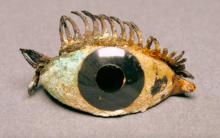In the ancient Mediterranean world, colors emerged from the body of the earth to form visible worlds on her surface. Explorations of color were fundamental to philosophical investigations into the nature of the universe. Later devalued within a Cartesian system that elevated dematerialized ideals, colors have not been treated as constitutive, despite their unavoidable material presence. This paper will briefly distinguish between pre-Newtonian understandings of color as material, which was active throughout the ancient Mediterranean world, and a post-Newtonian dissolution of that materiality into light. Building on a material notion of color in the ancient Mediterranean world, I will focus, in particular, on the artistic practice of inlaying eyes. Moving past traditional notions of naturalism, which have been marshalled in service of promoting ancient Greek exceptionalism, I will look at inlaid eyes as exempla of artistic arguments about seeing and being seen in vibrant material color. I suggest that looking at the materiality of color in this way also helps align Greek art with artistic practices throughout the wider ancient world, destabilizing the artificial divides of media, time, and place that color in fact traverses.
